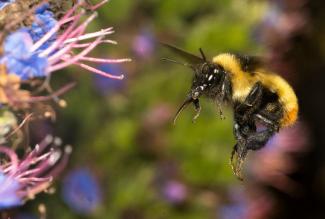
Image Credit: Alberto Rossettini
>>Skip to Identifying Pollinators
Pollinator Diversity
Collecting information about the bee diversity and abundance in your own garden, or in your community garden helps us keep track of how the variety of bees and their abundances over time. Experiment with different types of flowering plants over successive seasons to see which appear to attract a greater number of pollinators.
The Importance of Pollinators
For all the important work they do, most people only know two different pollinators; the honey bee and the bumblebee. The reality is that there are more than 3,000 bee species and more than 40 different kinds of bumblebees in North America alone! Important pollinators besides bees include flies, wasps, moths, beetles, hummingbirds, bats, and other animals.
Pollinators play an important role in every ecosystem. For humans, more than 1/3 of the food that we eat relies on pollinators for production. For other species, the significance is even greater, as more than ¾ of the world’s plants reproduce with the help of pollinators. These pollinator-dependent plants form the base of most food webs, and as a result, almost all species are directly or indirectly influenced by pollinators.
Native Pollinators are Declining
Unfortunately, in recent years there have been drastic declines in the diversity of native pollinators. Since pollinator density and diversity are essential for crop yields for many species (Klein et al. 2007, “Importance of pollinators in changing landscapes for world crops”, RSBP Royal Society Publishing), reductions in pollinator ecosystem services can lead to dramatic declines in crop yields. Habitat loss or degradation are the main factors responsible for the decline of pollinator richness and abundance.
Competition with European honeybees is also thought to worsen the challenges that native pollinators face. Honeybees have been experiencing drastic abundance declines. Restoring and maintaining native pollinator species is crucial for agricultural production.
Pollinator-dependent plants form the base of most food webs, and as a result, almost all species are directly or indirectly influenced by pollinators.
Identifying different pollinators
Familiarize yourself with the different bees you might find in your garden:
Flies, such as hover flies, may be present in your garden as pollinators. Flies have shorter antennae, often have large eyes, can hover, unlike bees who cannot, only one pair of wings, and do not carry large loads of pollen, unlike bees.

Image Credit: Katy Wrathall

Image Credit: Daniel Schiersner
Bees, on the other hand, are usually hairy, carry pollen on their bodies (on their legs, the underside of their bodies, on their legs and thorax). Bees range in size from very large to tiny. They may be black, brown, metallic green, brown, yellow, or metallic blue. They may be striped or solid colored.
There are three groups of bees we would find in Portland: Social bees (honeybees, bumblebees), Solitary bees (75% of all bees), and Cuckoo bees (20% of all bees). The most abundant bees in Portland gardens are honeybees, bumble bees, and sweat bees.

Image Credit: Pimthida
Bumble bees can be very large, and have robust, fuzzy bodies and they are mostly black with some yellow stripes. They are generalists and forage on many types of flowers. They carry pollen on the upper part of their hind legs. They make a low buzzy sound when they fly. [Image] Vosnesensky’s bumble bee is very common on the west coast of the US and is probably increasing.

Image Credit: ahmed m
Honey bees are the bees everyone recognizes. [Image] The very common honeybee was brought to North America early in the 1600’s. They often dangle their legs while they fly. Honeybees have been decreasing because of colony collapse disorder.

Image Credit: TCDavis
Dialictus is a type of bee called sweat bee. They are attracted to the salt in human sweat. They are small, and are dusky black or dull green or blue in color with hair on their abdomen in bands.

Image Credit:TJ Gehling